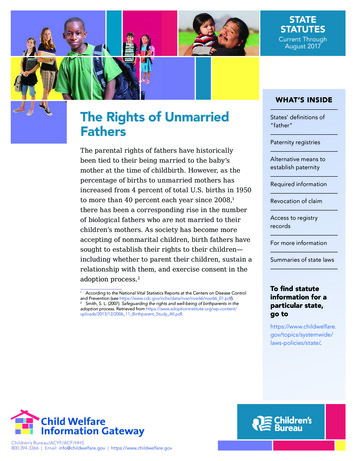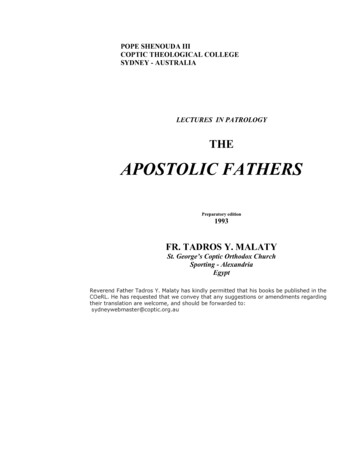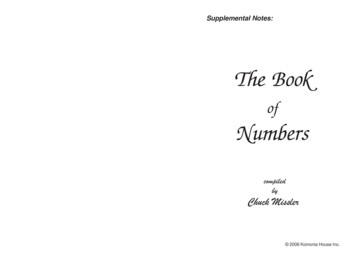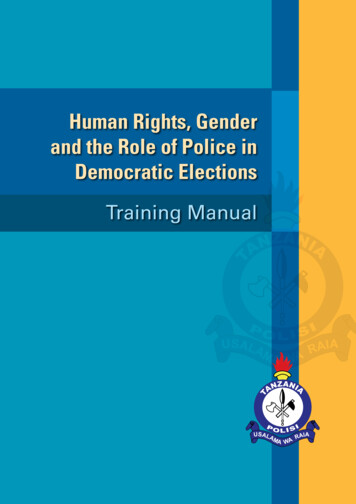
Transcription
STATESTATUTESCurrent ThroughAugust 2017WHAT’S INSIDEThe Rights of UnmarriedFathersThe parental rights of fathers have historicallybeen tied to their being married to the baby’smother at the time of childbirth. However, as theStates’ definitions of“father”Paternity registriesAlternative means toestablish paternitypercentage of births to unmarried mothers hasRequired informationto more than 40 percent each year since 2008,1Revocation of claimof biological fathers who are not married to theirAccess to registryrecordsincreased from 4 percent of total U.S. births in 1950there has been a corresponding rise in the numberchildren’s mothers. As society has become moreaccepting of nonmarital children, birth fathers haveFor more informationincluding whether to parent their children, sustain aSummaries of state lawssought to establish their rights to their children—relationship with them, and exercise consent in theadoption process.2According to the National Vital Statistics Reports at the Centers on Disease Controland Prevention (see https://www.cdc.gov/nchs/data/nvsr/nvsr66/nvsr66 01.pdf).2Smith, S. L. (2007). Safeguarding the rights and well-being of birthparents in theadoption process. Retrieved from ds/2013/12/2006 11 Birthparent Study All.pdf.1To find statuteinformation for aparticular state,go aws-policies/state/.Children’s Bureau/ACYF/ACF/HHS800.394.3366 Email: info@childwelfare.gov https://www.childwelfare.gov
https://www.childwelfare.govThe Rights of Unmarried FathersOver the past several decades, unmarried fathers havechallenged the termination of their parental rights underthe 14th Amendment in cases in which birth mothersrelinquished their children for adoption. In a series ofcases involving unmarried fathers, the U.S. SupremeCourt affirmed the constitutional protection of sucha father’s parental rights when he has established asubstantial relationship with his child. The court foundthat the existence of a biological link between a childand an unmarried father gives the father the opportunityto establish a substantial relationship, which it definedas the father’s commitment to the responsibilities ofparenthood, as demonstrated by being involved orattempting to be involved in the child’s upbringing.3 An “acknowledged father” is a man who hasestablished a father-child relationship by signing anacknowledgment of paternity.For this publication, laws for making determinations ofparentage were collected for all states, the District ofColumbia, and the U.S. territories, and an analysis of thisinformation informs the discussion that follows. He and the child’s mother are or were married to eachother, and the child is born during the marriage orwithin 300 days after the marriage ended.States’ Definitions of “Father”While there is no standard definition of “father” instatutes across the states, there are a number of termsthat describe the status of a parent-child relationshipbetween a man and his child. The term “legal father”generally refers to a man married to the mother atthe time of conception or birth of their child or whosepaternity has been otherwise determined by a court ofcompetent jurisdiction. When the parents of a child arenot married to one another, states use an array of termsto describe the status of a man who may be the biologicalfather. These terms include the following: An “adjudicated father” is a man who has beenadjudicated by a court of competent jurisdiction to bethe father of a child. A “presumed father” is a man who is recognized asthe father of a child until that status is rebutted orconfirmed in a judicial proceeding.In approximately 27 states, the District of Columbia,American Samoa, and the Northern Mariana Islands, aman may be presumed to be the father of a child in any ofthe following circumstances:4 Before the birth of the child, he and the child’s motherattempted to marry, and the marriage is or could beannulled, and the child is born during the marriage orwithin 300 days after the marriage is terminated. He has acknowledged his paternity in writing. He is obligated to support the child, either byvoluntary agreement or court order. While the child is a minor, he has resided with the childand openly claimed the child as his biological child. A “putative father” is a man who is the allegedbiological father of a child but whose paternity has notbeen legally established. An “alleged father” is a man who alleges himself tobe, or is alleged to be, the genetic father or a possiblegenetic father of a child but whose paternity has notbeen determined.Stanley v. Illinois, 405 U.S. 645 (1972); Quilloin v. Walcott, 434 U.S. 246 (1978);Caban v. Mohammed, 441 U.S. 380 (1979); Lehr v. Robertson, 463 U.S. 248(1983).3The word “approximately” is used to stress the fact that states frequentlyamend their laws. This information is current through August 2017. Alabama,Arizona, Arkansas, California, Colorado, Delaware, Hawaii, Idaho, Kansas,Maine, Massachusetts, Minnesota, Missouri, Montana, Nevada, New Jersey,New Mexico, North Dakota, Ohio, Oregon, Rhode Island, South Carolina,Tennessee, Texas, Virginia, Washington, and Wisconsin use one or more of theelements listed to define a presumed father.4This material may be freely reproduced and distributed. However, when doing so, please credit Child Welfare Information Gateway.This publication is available online at s-policies/statutes/putative/.2
The Rights of Unmarried Fathershttps://www.childwelfare.govPaternity Registriesof asserting his paternity.9 A man, the child, the child’smother, or other interested persons also may petitionthe court to establish a man’s paternity. The court, afterweighing all available evidence, will make a determinationof the child’s paternity.Before a man can assert any rights with regard to the careof a nonmarital child, he must first establish his paternityof the child. Many states have provisions for a father tovoluntarily acknowledge paternity or the possibility ofpaternity of a child born outside of marriage and recordthe fact in a putative father registry. Approximately 25states have established registries for this purpose.5 In 22states, the District of Columbia, and the Virgin Islands,there are provisions for voluntary acknowledgment ofpaternity through forms that are filed with social servicesdepartments, registrars of vital statistics, or other similarentities.6Acknowledgment of paternity or registration with aputative father registry ensures certain rights for anunmarried father, such as the right to receive notice ofcourt proceedings regarding the child, petitions foradoption, and actions to terminate parental rights. In11 states with putative father registries, filing with theregistry is the primary means for establishing this right ofnotice.7 An acknowledged father also may seek visitationwith the child and usually will be required to providefinancial support to the child.Alternative Means of EstablishingPaternityIn 21 states, Guam, and the Northern Mariana Islands,a person may claim paternity to a child by filing anacknowledgment or affidavit of paternity with a court.8In 26 states, American Samoa, and the Northern MarianaIslands, a man may consent to the placement of hisname as father on a child’s certificate of birth as a meansIn 41 states, the District of Columbia, and the VirginIslands, a court may order the alleged father, the child,the child’s mother, and any other man making a claimof paternity to submit to blood and other genetic testsas a means of determining the biological parentageof a child. When the results of genetic tests reveal thatthere is a high statistical probability that a man is thebiological father of a child, the court will make a judgmentof paternity.10 In 15 states, a man can be declared not tobe a child’s father (or a prior judgment of paternity maybe nullified) when genetic tests exclude the man as thechild’s biological father.11Required InformationStates differ in the information they require forregistration or acknowledgment of paternity. Theinformation that is needed to complete the registrationtypically includes the following: The full name, Social Security number, date of birth,and address of each parent The full name, date of birth, and residence of the child A signed, witnessed statement by the birth motherconsenting to the acknowledgment of paternity A signed, witnessed statement by the birth fatheracknowledging his paternityAlabama, Arizona, Arkansas, California, Colorado, Connecticut, Delaware,Florida, Georgia, Hawaii, Kansas, Kentucky, Massachusetts, Minnesota,Missouri, Montana, New Hampshire, New Jersey, New Mexico, NewYork, North Dakota, Rhode Island, South Carolina, Tennessee, Texas, andWashington.10Alaska, Arizona, California, Colorado, Connecticut, Florida, Georgia, Hawaii,Idaho, Illinois, Indiana, Iowa, Kansas, Kentucky, Louisiana, Maine, Maryland,Mississippi, Missouri, Montana, Nebraska, Nevada, New Jersey, New York,North Carolina (when the child is age 3 or older), North Dakota, Ohio, Oregon,Pennsylvania, Rhode Island, South Carolina, South Dakota, Tennessee, Texas,Utah, Vermont, Virginia, Washington, West Virginia, Wisconsin, and Wyoming.11Alabama, Arizona, California, Idaho, Indiana, Michigan, Minnesota,Mississippi, Missouri, North Carolina, South Dakota, Texas, Utah, West Virginia,and Wisconsin.9Alabama, Arizona, Arkansas, Delaware, Florida, Georgia, Illinois, Indiana,Iowa, Louisiana, Minnesota, Missouri, Montana, Nebraska, New Hampshire,New Mexico, New York, North Dakota, Ohio, Oklahoma, South Carolina,Tennessee, Texas, Virginia, and Wyoming.6Alaska, California, Hawaii, Idaho, Kansas, Kentucky, Maine, Maryland,Massachusetts, Mississippi, Nevada, New Jersey, North Carolina, Oklahoma,Oregon, Pennsylvania, Rhode Island, South Dakota, Utah, Vermont,Washington, and Wisconsin.7Alabama (for births occurring after January 1, 1997), Georgia, Illinois,Indiana, Minnesota, Missouri, Montana, New Hampshire, South Carolina,Tennessee, and Virginia.8Alabama, Arizona, Arkansas, Connecticut, Florida, Idaho, Illinois, Indiana,Iowa, Kentucky, Louisiana, Maryland, Massachusetts, Michigan, Mississippi,New Hampshire, New Mexico, North Dakota, Rhode Island, Texas, andVirginia.5This material may be freely reproduced and distributed. However, when doing so, please credit Child Welfare Information Gateway.This publication is available online at s-policies/statutes/putative/.3
https://www.childwelfare.govThe Rights of Unmarried Fathers The signatures of the mother of the child and thebiological father The date the registration or acknowledgment wascompletedIn many states, the acknowledgment of paternity formalso will provide essential information to the registrants,including the following: A statement of rights and responsibilities, includingany rights afforded to a minor parent A statement of the alternatives to and consequencesof signing the acknowledgment Information concerning the legal implications ofcompleting the form, including the procedurefor establishing parentage, parental rights andresponsibilities, and child support obligations A statement that the man who signs the form isacknowledging that he is the biological father of thechild named in the form and that he assumes theparental duty of support of that childRevocation of ClaimApproximately 48 states, the District of Columbia, and theVirgin Islands make provisions in their statutes that allowputative fathers to revoke or rescind a notice of intentto claim paternity.12 Of these states, approximately 11allow revocation at any time.13 Revocation is effective onlyafter the child’s birth in Arkansas and Iowa. In Florida, aregistration that is submitted prior to a child’s birth maybe withdrawn only prior to the child’s birth. Approximately31 states, the District of Columbia, and the Virgin Islandslimit the right of rescission to 60 days after the paternityclaim is submitted or prior to a court proceeding toAlabama, Alaska, Arizona, Arkansas, California, Colorado, Connecticut,Delaware, Florida, Georgia, Hawaii, Idaho, Illinois, Indiana, Iowa, Kansas,Louisiana, Maine, Maryland, Massachusetts, Michigan, Minnesota, Mississippi,Missouri, Montana, Nebraska, Nevada, New Hampshire, New Jersey, NewMexico, New York, North Carolina, North Dakota, Ohio, Oklahoma, Oregon,Pennsylvania, Rhode Island, South Carolina, South Dakota, Tennessee, Texas,Utah, Vermont, Virginia, Washington, Wisconsin, and Wyoming.13Alabama, Delaware, Missouri, Montana, New Mexico, New York, Oklahoma,South Carolina, Tennessee, Wisconsin, and Wyoming.12establish paternity, whichever occurs first.14 In 25 statesand the Virgin Islands, a claim of paternity may not berevoked after the 60-day period except by court action onthe basis of fraud, duress, or material mistake of fact.15Access to Registry RecordsAccess to information maintained in paternity registriesalso varies from state to state. Many jurisdictions permitcertain persons access to registry records. In general,these are people with a direct interest in a case. Typically,persons entitled to access include birth mothers, courts,attorneys, licensed adoption agencies, prospectiveadoptive parents, state departments of social services,state offices of child support enforcement, registries ofstates, or any other person upon a court order for goodcause.For More InformationThe following resources provide additional informationabout the issues discussed in this publication:Putative Father Registry [webpage] (Academy ofAdoption and Assisted Reproduction irth-parents/putative-father-registryThe Importance of Establishing Paternity [webpage](National Responsible Fatherhood Clearinghouse): ntial-fathers/paternity“Establishing Fatherhood” [Child Support Handbookchapter] (U.S. Department of Health and Human Services,Administration for Children and Families, Office of ChildSupport Enforcement): ms/css/chapter3 0.pdfAlaska, Arizona, California, Connecticut, Florida, Georgia, Hawaii, Idaho,Illinois, Indiana, Iowa, Louisiana, Maine, Maryland, Massachusetts, Mississippi,Montana, Nebraska, Nevada, New Hampshire, New Jersey, North Dakota,Ohio, Oregon, Pennsylvania, South Carolina, Texas, Utah, Vermont, Virginia,and Washington.15Alaska, Arizona, Connecticut, Florida, Georgia, Hawaii, Idaho, Illinois,Louisiana, Maine, Maryland, Massachusetts, Mississippi, Nebraska, Nevada,New Hampshire, New Jersey, North Dakota, Ohio, Oregon, Pennsylvania,South Carolina, Texas, Utah, and Virginia.14This material may be freely reproduced and distributed. However, when doing so, please credit Child Welfare Information Gateway.This publication is available online at s-policies/statutes/putative/.4
The Rights of Unmarried Fathershttps://www.childwelfare.govSafeguarding the Rights and Well-Being of Birthparentsin the Adoption Process (Evan B. Donaldson AdoptionInstitute): ds/2013/12/2006 11 Birthparent Study All.pdfThis publication is a product of the State StatutesSeries prepared by Child Welfare InformationGateway. While every attempt has been madeto be complete, additional information on thesetopics may be in other sections of a state’s codeas well as agency regulations, case law, andinformal practices and procedures.Suggested citation:Child Welfare Information Gateway. (2018). The rights ofunmarried fathers. Washington, DC: U.S. Department ofHealth and Human Services, Children’s Bureau.This material may be freely reproduced and distributed. However, when doing so, please credit Child Welfare Information Gateway.This publication is available online at s-policies/statutes/putative/.5
The Rights of Unmarried Fathershttps://www.childwelfare.govAlabamaCurrent Through August 2017Legal Definition of ‘Father’Citation: Ala. Code §§ 26-17-102; 26-17-204An acknowledged father is a man who has established a father-child relationship. An adjudicated father is a man who has beenadjudicated by a court to be the father of a child. An alleged father is a man who alleges himself to be, or is alleged to be, thegenetic father or a possible genetic father of a child but whose paternity has not been determined. A presumed father is a man whois recognized as the father of a child until that status is rebutted or confirmed in a judicial proceeding. A putative father is the allegedor reputed father.A man is presumed to be the natural father of a child if any of the following apply: He and the child’s mother are married to each other, and the child is born during the marriage. He and the child’s mother are or have been married to each other, and the child is born during the marriage or within 300 daysafter the marriage is terminated. Before the child’s birth he and the mother attempted to marry each other, although the attempted marriage is or could bedeclared invalid. After the child’s birth, he and the child’s mother married or attempted to marry each other, although the attempted marriageis or could be declared invalid, and:» He has acknowledged his paternity of the child in writing, the writing being filed with the appropriate court or the Office ofVital Statistics.» With his consent, he is named as the child’s father on the child’s birth certificate.» He is otherwise obligated to support the child either under a written voluntary promise or by court order. While the child is a minor, he receives the child into his home or otherwise openly holds out the child as his natural child orotherwise provides emotional and financial support for the child. He acknowledges his paternity of the child in a writing filed in accordance with provisions of the legitimation statute.Paternity RegistryCitation: Ala. Code § 26-10C-1The Department of Human Resources shall establish a putative father registry that shall record the name, Social Security number,date of birth, and address of the following: Any person adjudicated by a court of this state to be the father of a child born out of wedlock Any person who has filed with the registry, before or after the birth of a child born out of wedlock, a notice of intent to claimpaternity of the child that includes the information required in the subsection below Any person adjudicated by a court of another state or territory of the United States to be the father of a child born out ofwedlock, where a certified copy of the court order has been filed with the registry by the person or any other person Any person who has filed with the registry an instrument acknowledging paternity pursuant to §§ 26-11-1 through 26-11-3This subsection shall be the exclusive procedure available for any person who claims to be the natural father of a child born out ofwedlock on or after January 1, 1997, to entitle that person to notice of and the opportunity to contest any adoption proceeding filedand pending on or after January 1, 1997.Alternate Means to Establish PaternityCitation: Ala. Code §§ 26-11-2; 26-17-201; 26-17-631A father of a nonmarital child may seek to legitimate the child and render him or her capable of inheriting his estate by filing a noticeof declaration of legitimation in writing attested by two witnesses; setting forth the name of the child, supposed age, and the nameof mother; and stating that he thereby recognizes him or her as his child and capable of inheriting his estate, real and personal, as ifborn in wedlock.The father-child relationship may be established between a man and a child by: An unrebutted presumption of the man’s paternity of the child under § 26-17-204 An effective acknowledgment of paternity by the man under Article 3 An adjudication of the man’s paternity Adoption of the child by the man The man’s consent to assisted reproduction by a woman that resulted in the birth of the childThis material may be freely reproduced and distributed. However, when doing so, please credit Child Welfare Information Gateway.This publication is available online at s-policies/statutes/putative/.6
The Rights of Unmarried Fathershttps://www.childwelfare.govThe paternity of a child having a presumed, acknowledged, or adjudicated father may be disproved only by admissible results ofgenetic testing excluding that man as the father of the child or identifying another man as the father of the child.Required InformationCitation: Ala. Code § 26-10C-1A person filing a notice of intent to claim paternity of a child or an acknowledgment of paternity with the putative father registry shallinclude all of the following: The father’s name, Social Security number, date of birth, and current address The mother’s name and all other names known to the putative father that have been used by the mother, Social Securitynumber, date of birth, and address, if known The father’s current income and financial information with a child support obligation income statement/affidavit form to beprescribed by regulations of the department The child’s name and place of birth, if known The possible date or dates of sexual intercourseThe person filing shall notify the registry of any change of address pursuant to the procedures prescribed by regulation of thedepartment. The registration must be on a form prescribed by the department, signed by the putative father, and notarized.The putative father may file his notice of intent to claim paternity prior to the birth of the child.Revocation of Claim to PaternityCitation: Ala. Code § 26-10C-1(d)A person who has filed a notice of intent to claim paternity may at any time revoke a notice of intent to claim paternity previously filedand, upon receipt of the notification by the registry, the revoked notice of intent to claim paternity shall be deemed null and void.Access to InformationCitation: Ala. Code § 26-10C-1(f)The Department of Human Resources shall, upon request, provide the names and addresses of persons listed with the registryto any court. The information shall not be divulged to any other person except upon order of a court for good cause shown. Thedepartment, after receiving notice pursuant to § 26-10A-17 of the pendency of any adoption proceeding wherein the proposedadopted person is a child born within 300 days of the date or dates of sexual intercourse listed in the registry and to the samebiological mother listed in the registry, immediately shall send a copy of the notice of intent to claim paternity to the court handlingthe adoption.When the court handling the adoption receives said notice of the intent to claim paternity, the court shall forthwith give notice of thependency of the adoption proceeding to the putative father and notify the biological mother that the putative father has registeredin conformity with the putative father registry.AlaskaCurrent Through August 2017Legal Definition of ‘Father’This issue is not addressed in the statutes reviewed.Paternity RegistryCitation: Alaska Stat. §§ 18.50.165; 25.20.055The state registrar shall prepare a form for use in acknowledging paternity under § 25.20.055.When a birth occurs to an unmarried woman in a hospital, or on route to a hospital to which the woman is later admitted, the hospitalshall ensure that a staff member: Meets with the woman before her release from the hospital Attempts to meet with the father of the unmarried woman’s child, if possible Presents to the mother and, if possible, the father, a pamphlet or statement regarding the rights and responsibilities of anatural parentThis material may be freely reproduced and distributed. However, when doing so, please credit Child Welfare Information Gateway.This publication is available online at s-policies/statutes/putative/.7
The Rights of Unmarried Fathershttps://www.childwelfare.gov Provides to the mother and, if possible, the father, all forms, statements, or agreements necessary to voluntarily establish aparent and child relationship, including an acknowledgment of paternity form prepared under § 18.50.165 On request of the mother and father, assists the father in completing specific forms, statements, or agreements necessary toestablish a parent and child relationship between the father and the child On request of the mother and father, mails a completed voluntary acknowledgment of paternity form to the state registrar forfilingWhen a birth occurs to an unmarried woman who is not in a hospital for the birth nor admitted to a hospital immediately after thebirth, and the birth is attended by a physician, certified nurse midwife, or certified direct-entry midwife, the physician, nurse midwife,or direct-entry midwife shall perform the duties described above or ensure that an agent performs those duties.When a birth occurs in a situation that is not covered by either situation described above, any adult may, upon request of the fatherand mother, assist them in filing a voluntary acknowledgment of paternity form with the state registrar under § 18.50.165.Alternate Means to Establish PaternityCitation: Alaska Stat. § 25.20.050A child born out of wedlock is legitimated and considered the heir of the putative parent when: The putative parent subsequently marries the undisputed parent of the child. For acknowledgments made before July 1, 1997, the putative parent acknowledges, in writing, being a parent of the child. For acknowledgments made on or after July 1, 1997, the putative father and the mother both sign a form for acknowledgingpaternity under § 18.50.165. The putative parent is determined, upon sufficient evidence, by a superior court without a jury or by another tribunal to be aparent of the child. Acceptable evidence includes:» Evidence that the putative parent’s conduct and bearing toward the child, either by word or act, indicates that the child isthe child of the putative parent» The results of a genetic test that is of a type generally acknowledged as reliableA genetic test that establishes a probability of parentage at 95 percent or higher creates a presumption of parentage that may berebutted only by clear and convincing evidence.Required InformationCitation: Alaska Stat. § 18.50.165The form must include: A statement that the man who signs the form is acknowledging that he is the natural father of the child named in the form andthat he assumes the parental duty of support of that child The address and Social Security number of both parents of the child named on the form Signature lines for both parents A signature line for either a witness or notary public A statement that sets out the legal consequences to and the rights and responsibilities of the mother and the manacknowledging paternity of signing the formRevocation of Claim to PaternityCitation: Alaska Stat. § 18.50.165The mother and the man acknowledging paternity must be notified that, unless fraud, duress, or material mistake of fact is shown inaccordance with § 25.20.050, the acknowledgment may only be rescinded by the earlier of the following dates: Sixty days after the date of the person’s signature The date of initiation of an administrative or judicial procedure to establish support of the child in which the person is a partyAccess to InformationThis issue is not addressed in the statutes reviewed.This material may be freely reproduced and distributed. However, when doing so, please credit Child Welfare Information Gateway.This publication is available online at s-policies/statutes/putative/.8
The Rights of Unmarried Fathershttps://www.childwelfare.govAmerican SamoaCurrent Through August 2017Legal Definition of ‘Father’Citation: A.S. Code § 45.0103(21)The term ‘parent’ means either a natural parent of a legitimate child, a parent by adoption, or the natural parent of an illegitimatechild. A child born to a woman married at the time of its conception or birth is presumed to be the legitimate child of her husband. Inthe event that the mother is legally married to a different man at the time of birth than she was at the time of conception, the child ispresumed to be the legitimate child of her husband at the time of conception. If this presumption is legally rebutted and no contrarydetermination is made, the man to whom the mother is married at the time of the child’s birth is presumed to be the legitimate fatherof the child.Paternity RegistryThis issue is not addressed in the statutes reviewed.Alternate Means to Establish PaternityCitation: A. S. Code §§ 45.0103(21); 45.1501; 45.1502The father of an illegitimate child has no parental rights to the child unless, prior to entry of a decree of adoption, he hasacknowledged the child as his own by affirmatively asserting paternity, as follows: Causing his name to be affixed to the birth certificate of the child Paying medical or hospital bills associated with the birth of the child Paying support for the child Otherwise asserting his paternity in writingProceedings to establish the paternity of a child and to compel support under this chapter may be commenced by the mother,whether a minor or not; by the child’s guardian; or, if the mother or the child is a public charge, by the Department of Health. Noproceeding may be initiated after the child is age 5 or older unless paternity has been acknowledged by the father in writing or byfurnishing support.Proceedings under this chapter are started by the filing of a verified petition alleging that the person named as respondent is thefather of the child and requesting the court to enter a declaration of paternity, an order of support, or any
there is a high statistical probability that a man is the biological father of a child, the court will make a judgment of paternity. 10. In 15 states, a man can be declared not to be a child’s father (or a prior judgment of paternity may be nullified) when genetic tests exclude the man a










